Implementation of EMS in Australian Agriculture Sector Report
VerifiedAdded on 2023/06/05
|10
|2215
|313
Report
AI Summary
This report delves into the implementation of Environmental Management Systems (EMS) within the Australian agricultural sector, focusing on its viability and benefits. The study explores the driving forces behind EMS adoption, including government and industry investments aimed at addressing environmental issues. A key research question investigates the benefits of EMS for the sector. The discussion section examines various studies, including the challenges of mitigating agricultural pollution and the importance of farmer acceptance of mitigation strategies. It also considers the mixed responses to government-supported programs, the impact of EMS on the olive oil industry, and the role of institutional pressures in shaping environmental strategies. Furthermore, the report highlights the use of agricultural by-products, the potential of wind energy, and the application of life cycle assessment in EMS. The conclusion emphasizes that while EMS aims to reduce environmental impact and increase efficiency, farmer adoption is often driven by financial incentives. The report also highlights the mitigation procedures included the strategies that emphasized on the cost neutral and low-cost measures and cost later on was found to be the most desired criteria for the farmers.
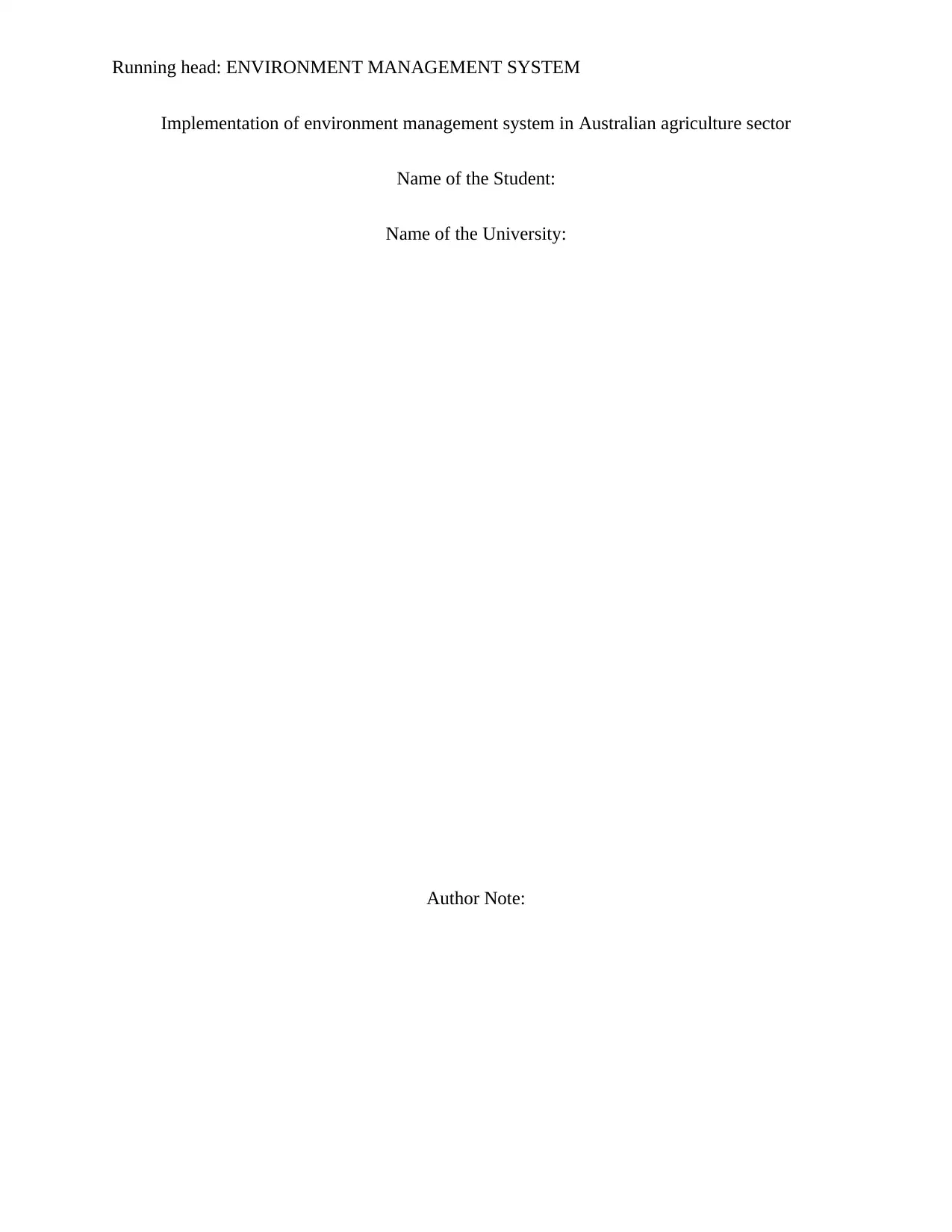
Running head: ENVIRONMENT MANAGEMENT SYSTEM
Implementation of environment management system in Australian agriculture sector
Name of the Student:
Name of the University:
Author Note:
Implementation of environment management system in Australian agriculture sector
Name of the Student:
Name of the University:
Author Note:
Paraphrase This Document
Need a fresh take? Get an instant paraphrase of this document with our AI Paraphraser
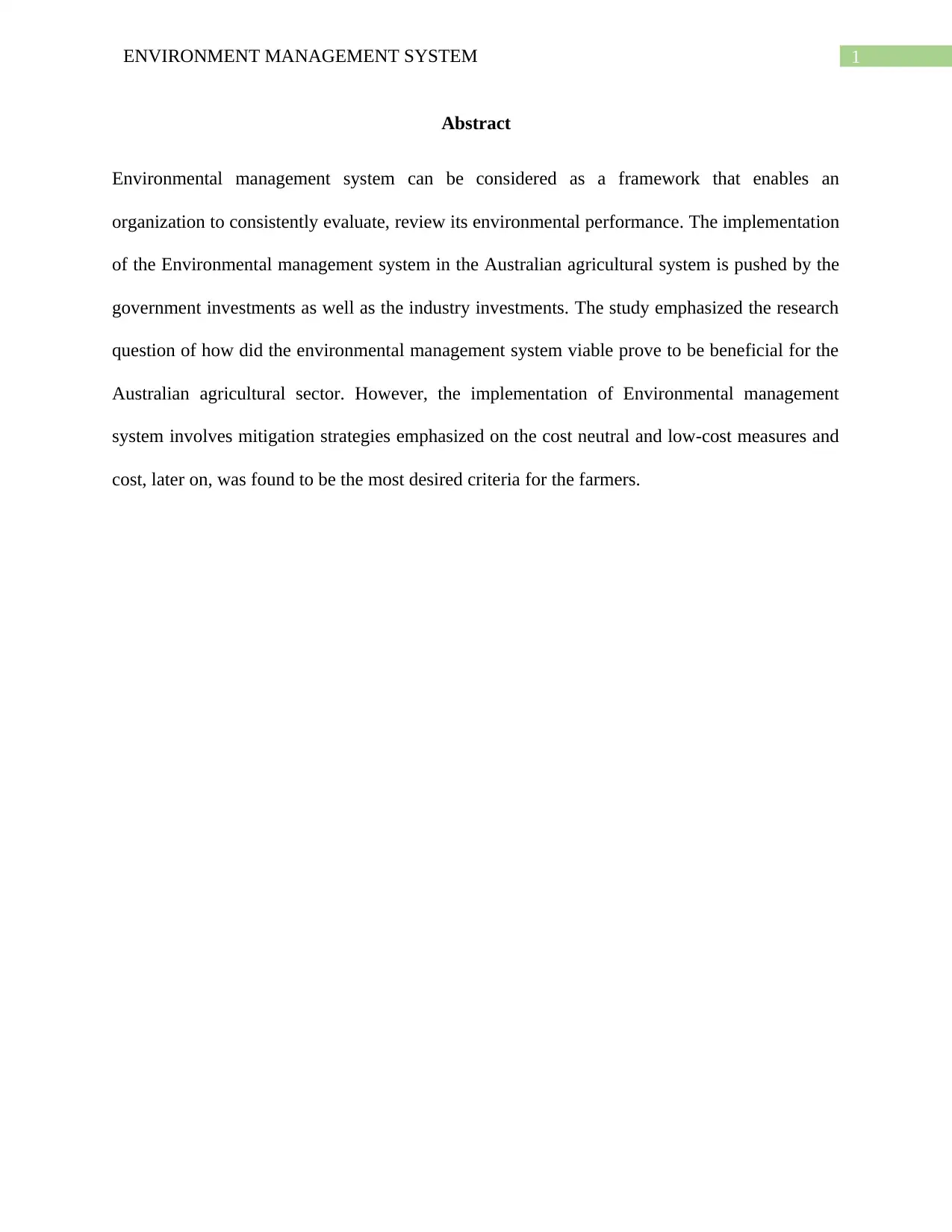
1ENVIRONMENT MANAGEMENT SYSTEM
Abstract
Environmental management system can be considered as a framework that enables an
organization to consistently evaluate, review its environmental performance. The implementation
of the Environmental management system in the Australian agricultural system is pushed by the
government investments as well as the industry investments. The study emphasized the research
question of how did the environmental management system viable prove to be beneficial for the
Australian agricultural sector. However, the implementation of Environmental management
system involves mitigation strategies emphasized on the cost neutral and low-cost measures and
cost, later on, was found to be the most desired criteria for the farmers.
Abstract
Environmental management system can be considered as a framework that enables an
organization to consistently evaluate, review its environmental performance. The implementation
of the Environmental management system in the Australian agricultural system is pushed by the
government investments as well as the industry investments. The study emphasized the research
question of how did the environmental management system viable prove to be beneficial for the
Australian agricultural sector. However, the implementation of Environmental management
system involves mitigation strategies emphasized on the cost neutral and low-cost measures and
cost, later on, was found to be the most desired criteria for the farmers.
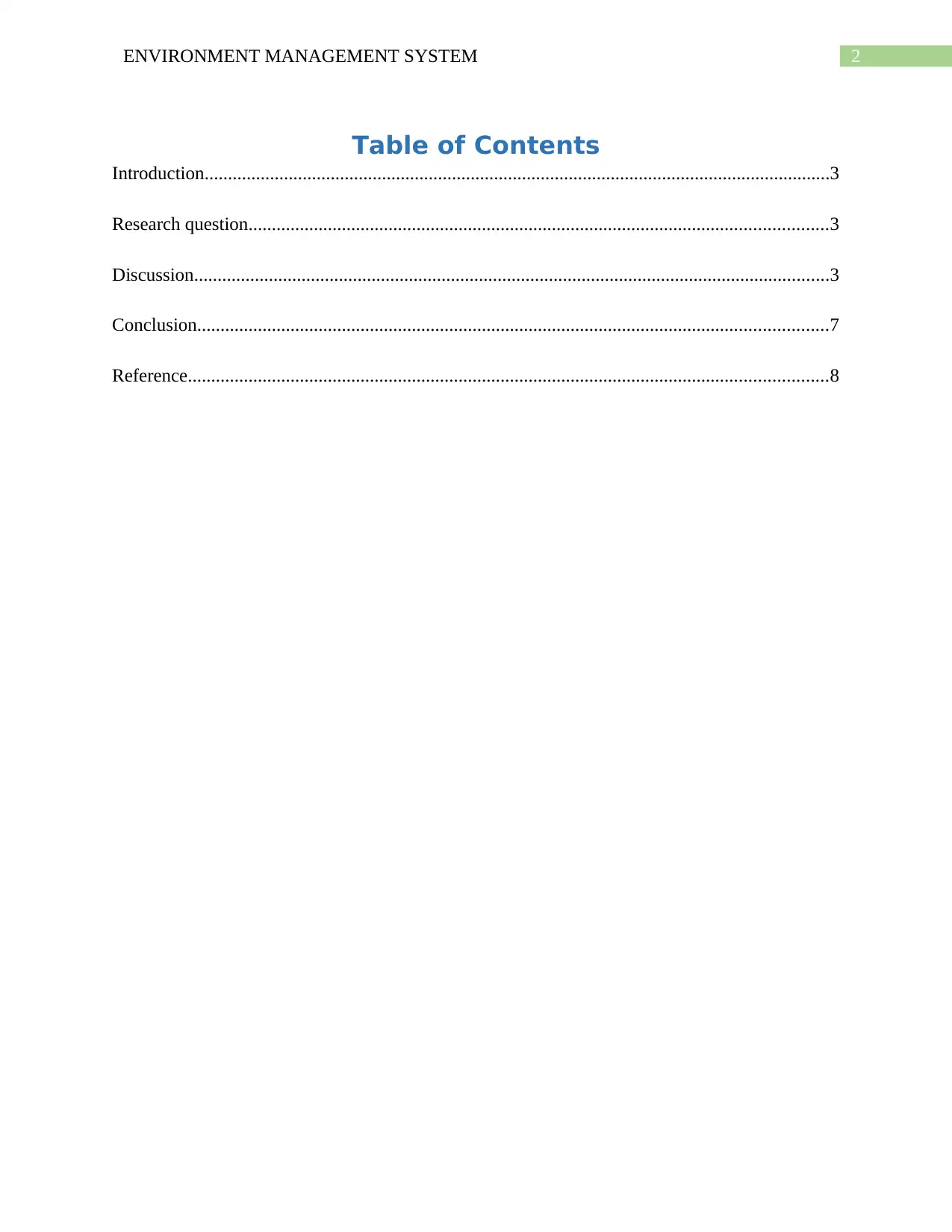
2ENVIRONMENT MANAGEMENT SYSTEM
Table of Contents
Introduction......................................................................................................................................3
Research question............................................................................................................................3
Discussion........................................................................................................................................3
Conclusion.......................................................................................................................................7
Reference.........................................................................................................................................8
Table of Contents
Introduction......................................................................................................................................3
Research question............................................................................................................................3
Discussion........................................................................................................................................3
Conclusion.......................................................................................................................................7
Reference.........................................................................................................................................8
⊘ This is a preview!⊘
Do you want full access?
Subscribe today to unlock all pages.

Trusted by 1+ million students worldwide
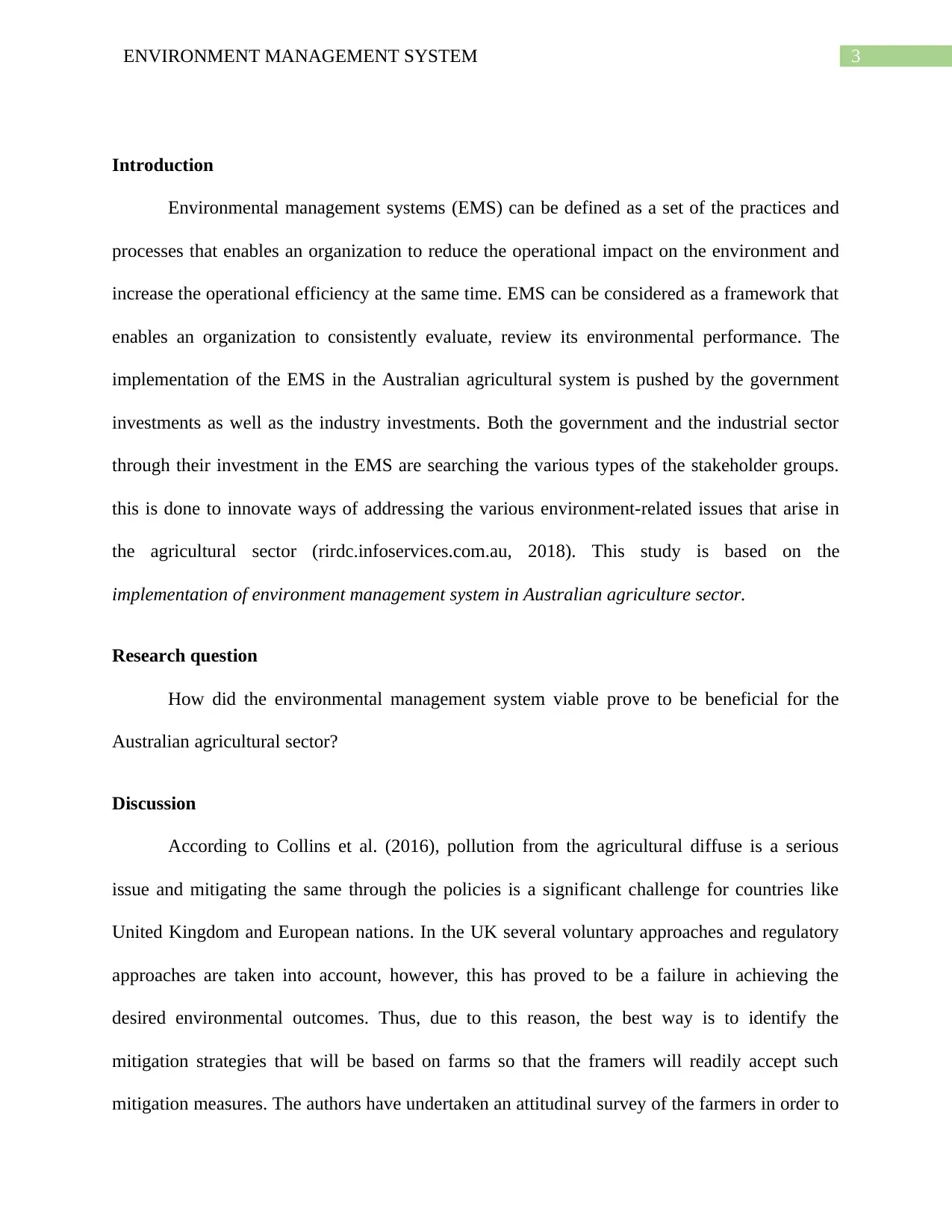
3ENVIRONMENT MANAGEMENT SYSTEM
Introduction
Environmental management systems (EMS) can be defined as a set of the practices and
processes that enables an organization to reduce the operational impact on the environment and
increase the operational efficiency at the same time. EMS can be considered as a framework that
enables an organization to consistently evaluate, review its environmental performance. The
implementation of the EMS in the Australian agricultural system is pushed by the government
investments as well as the industry investments. Both the government and the industrial sector
through their investment in the EMS are searching the various types of the stakeholder groups.
this is done to innovate ways of addressing the various environment-related issues that arise in
the agricultural sector (rirdc.infoservices.com.au, 2018). This study is based on the
implementation of environment management system in Australian agriculture sector.
Research question
How did the environmental management system viable prove to be beneficial for the
Australian agricultural sector?
Discussion
According to Collins et al. (2016), pollution from the agricultural diffuse is a serious
issue and mitigating the same through the policies is a significant challenge for countries like
United Kingdom and European nations. In the UK several voluntary approaches and regulatory
approaches are taken into account, however, this has proved to be a failure in achieving the
desired environmental outcomes. Thus, due to this reason, the best way is to identify the
mitigation strategies that will be based on farms so that the framers will readily accept such
mitigation measures. The authors have undertaken an attitudinal survey of the farmers in order to
Introduction
Environmental management systems (EMS) can be defined as a set of the practices and
processes that enables an organization to reduce the operational impact on the environment and
increase the operational efficiency at the same time. EMS can be considered as a framework that
enables an organization to consistently evaluate, review its environmental performance. The
implementation of the EMS in the Australian agricultural system is pushed by the government
investments as well as the industry investments. Both the government and the industrial sector
through their investment in the EMS are searching the various types of the stakeholder groups.
this is done to innovate ways of addressing the various environment-related issues that arise in
the agricultural sector (rirdc.infoservices.com.au, 2018). This study is based on the
implementation of environment management system in Australian agriculture sector.
Research question
How did the environmental management system viable prove to be beneficial for the
Australian agricultural sector?
Discussion
According to Collins et al. (2016), pollution from the agricultural diffuse is a serious
issue and mitigating the same through the policies is a significant challenge for countries like
United Kingdom and European nations. In the UK several voluntary approaches and regulatory
approaches are taken into account, however, this has proved to be a failure in achieving the
desired environmental outcomes. Thus, due to this reason, the best way is to identify the
mitigation strategies that will be based on farms so that the framers will readily accept such
mitigation measures. The authors have undertaken an attitudinal survey of the farmers in order to
Paraphrase This Document
Need a fresh take? Get an instant paraphrase of this document with our AI Paraphraser
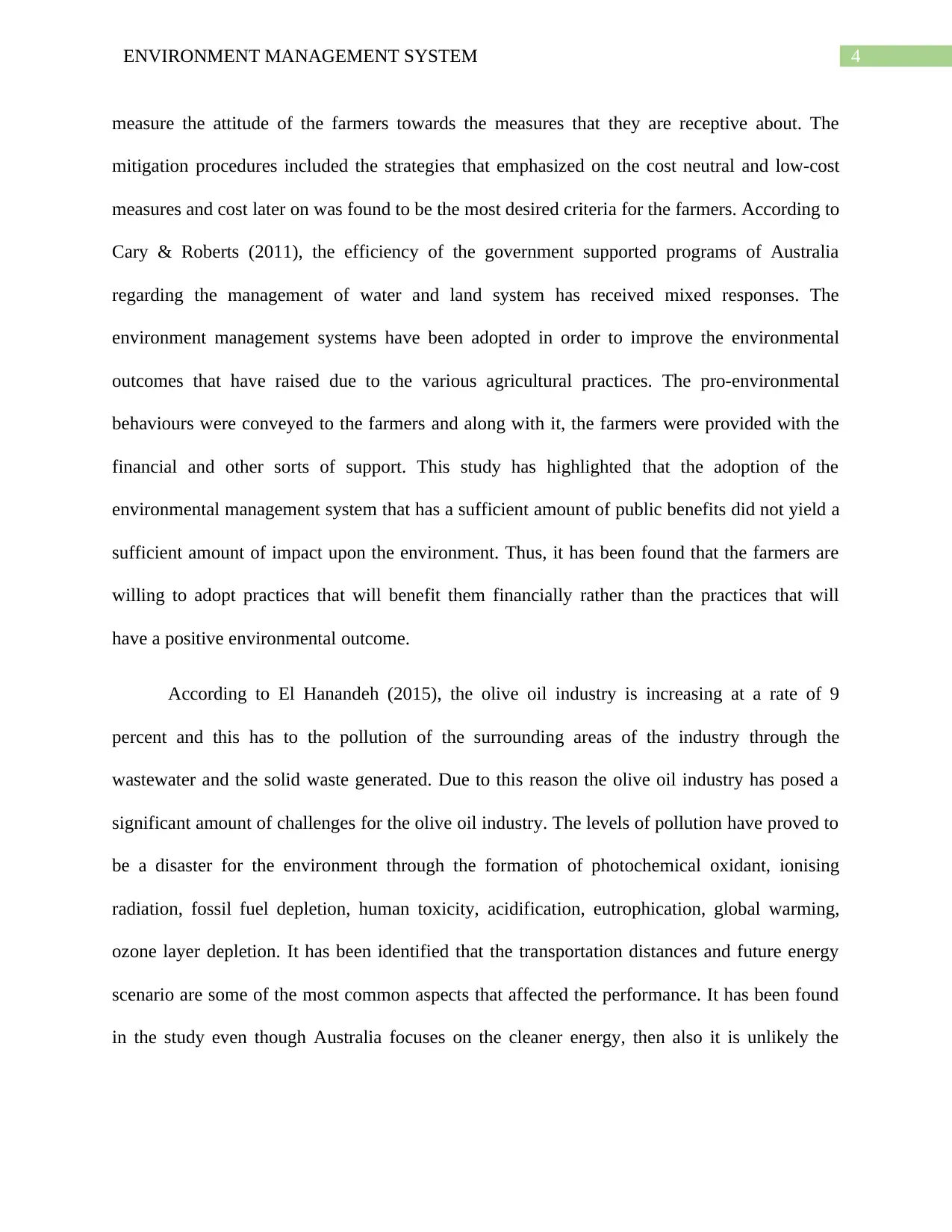
4ENVIRONMENT MANAGEMENT SYSTEM
measure the attitude of the farmers towards the measures that they are receptive about. The
mitigation procedures included the strategies that emphasized on the cost neutral and low-cost
measures and cost later on was found to be the most desired criteria for the farmers. According to
Cary & Roberts (2011), the efficiency of the government supported programs of Australia
regarding the management of water and land system has received mixed responses. The
environment management systems have been adopted in order to improve the environmental
outcomes that have raised due to the various agricultural practices. The pro-environmental
behaviours were conveyed to the farmers and along with it, the farmers were provided with the
financial and other sorts of support. This study has highlighted that the adoption of the
environmental management system that has a sufficient amount of public benefits did not yield a
sufficient amount of impact upon the environment. Thus, it has been found that the farmers are
willing to adopt practices that will benefit them financially rather than the practices that will
have a positive environmental outcome.
According to El Hanandeh (2015), the olive oil industry is increasing at a rate of 9
percent and this has to the pollution of the surrounding areas of the industry through the
wastewater and the solid waste generated. Due to this reason the olive oil industry has posed a
significant amount of challenges for the olive oil industry. The levels of pollution have proved to
be a disaster for the environment through the formation of photochemical oxidant, ionising
radiation, fossil fuel depletion, human toxicity, acidification, eutrophication, global warming,
ozone layer depletion. It has been identified that the transportation distances and future energy
scenario are some of the most common aspects that affected the performance. It has been found
in the study even though Australia focuses on the cleaner energy, then also it is unlikely the
measure the attitude of the farmers towards the measures that they are receptive about. The
mitigation procedures included the strategies that emphasized on the cost neutral and low-cost
measures and cost later on was found to be the most desired criteria for the farmers. According to
Cary & Roberts (2011), the efficiency of the government supported programs of Australia
regarding the management of water and land system has received mixed responses. The
environment management systems have been adopted in order to improve the environmental
outcomes that have raised due to the various agricultural practices. The pro-environmental
behaviours were conveyed to the farmers and along with it, the farmers were provided with the
financial and other sorts of support. This study has highlighted that the adoption of the
environmental management system that has a sufficient amount of public benefits did not yield a
sufficient amount of impact upon the environment. Thus, it has been found that the farmers are
willing to adopt practices that will benefit them financially rather than the practices that will
have a positive environmental outcome.
According to El Hanandeh (2015), the olive oil industry is increasing at a rate of 9
percent and this has to the pollution of the surrounding areas of the industry through the
wastewater and the solid waste generated. Due to this reason the olive oil industry has posed a
significant amount of challenges for the olive oil industry. The levels of pollution have proved to
be a disaster for the environment through the formation of photochemical oxidant, ionising
radiation, fossil fuel depletion, human toxicity, acidification, eutrophication, global warming,
ozone layer depletion. It has been identified that the transportation distances and future energy
scenario are some of the most common aspects that affected the performance. It has been found
in the study even though Australia focuses on the cleaner energy, then also it is unlikely the
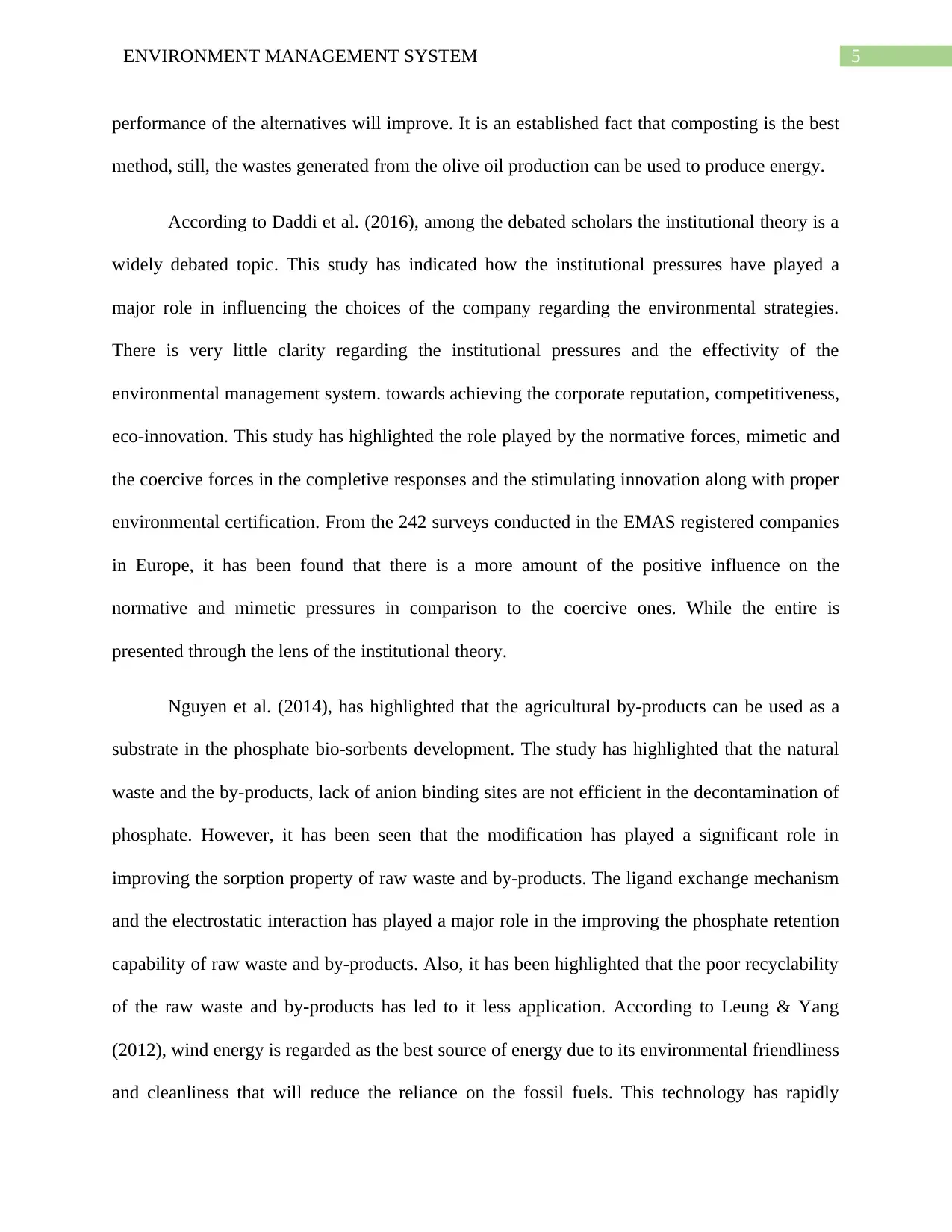
5ENVIRONMENT MANAGEMENT SYSTEM
performance of the alternatives will improve. It is an established fact that composting is the best
method, still, the wastes generated from the olive oil production can be used to produce energy.
According to Daddi et al. (2016), among the debated scholars the institutional theory is a
widely debated topic. This study has indicated how the institutional pressures have played a
major role in influencing the choices of the company regarding the environmental strategies.
There is very little clarity regarding the institutional pressures and the effectivity of the
environmental management system. towards achieving the corporate reputation, competitiveness,
eco-innovation. This study has highlighted the role played by the normative forces, mimetic and
the coercive forces in the completive responses and the stimulating innovation along with proper
environmental certification. From the 242 surveys conducted in the EMAS registered companies
in Europe, it has been found that there is a more amount of the positive influence on the
normative and mimetic pressures in comparison to the coercive ones. While the entire is
presented through the lens of the institutional theory.
Nguyen et al. (2014), has highlighted that the agricultural by-products can be used as a
substrate in the phosphate bio-sorbents development. The study has highlighted that the natural
waste and the by-products, lack of anion binding sites are not efficient in the decontamination of
phosphate. However, it has been seen that the modification has played a significant role in
improving the sorption property of raw waste and by-products. The ligand exchange mechanism
and the electrostatic interaction has played a major role in the improving the phosphate retention
capability of raw waste and by-products. Also, it has been highlighted that the poor recyclability
of the raw waste and by-products has led to it less application. According to Leung & Yang
(2012), wind energy is regarded as the best source of energy due to its environmental friendliness
and cleanliness that will reduce the reliance on the fossil fuels. This technology has rapidly
performance of the alternatives will improve. It is an established fact that composting is the best
method, still, the wastes generated from the olive oil production can be used to produce energy.
According to Daddi et al. (2016), among the debated scholars the institutional theory is a
widely debated topic. This study has indicated how the institutional pressures have played a
major role in influencing the choices of the company regarding the environmental strategies.
There is very little clarity regarding the institutional pressures and the effectivity of the
environmental management system. towards achieving the corporate reputation, competitiveness,
eco-innovation. This study has highlighted the role played by the normative forces, mimetic and
the coercive forces in the completive responses and the stimulating innovation along with proper
environmental certification. From the 242 surveys conducted in the EMAS registered companies
in Europe, it has been found that there is a more amount of the positive influence on the
normative and mimetic pressures in comparison to the coercive ones. While the entire is
presented through the lens of the institutional theory.
Nguyen et al. (2014), has highlighted that the agricultural by-products can be used as a
substrate in the phosphate bio-sorbents development. The study has highlighted that the natural
waste and the by-products, lack of anion binding sites are not efficient in the decontamination of
phosphate. However, it has been seen that the modification has played a significant role in
improving the sorption property of raw waste and by-products. The ligand exchange mechanism
and the electrostatic interaction has played a major role in the improving the phosphate retention
capability of raw waste and by-products. Also, it has been highlighted that the poor recyclability
of the raw waste and by-products has led to it less application. According to Leung & Yang
(2012), wind energy is regarded as the best source of energy due to its environmental friendliness
and cleanliness that will reduce the reliance on the fossil fuels. This technology has rapidly
⊘ This is a preview!⊘
Do you want full access?
Subscribe today to unlock all pages.

Trusted by 1+ million students worldwide
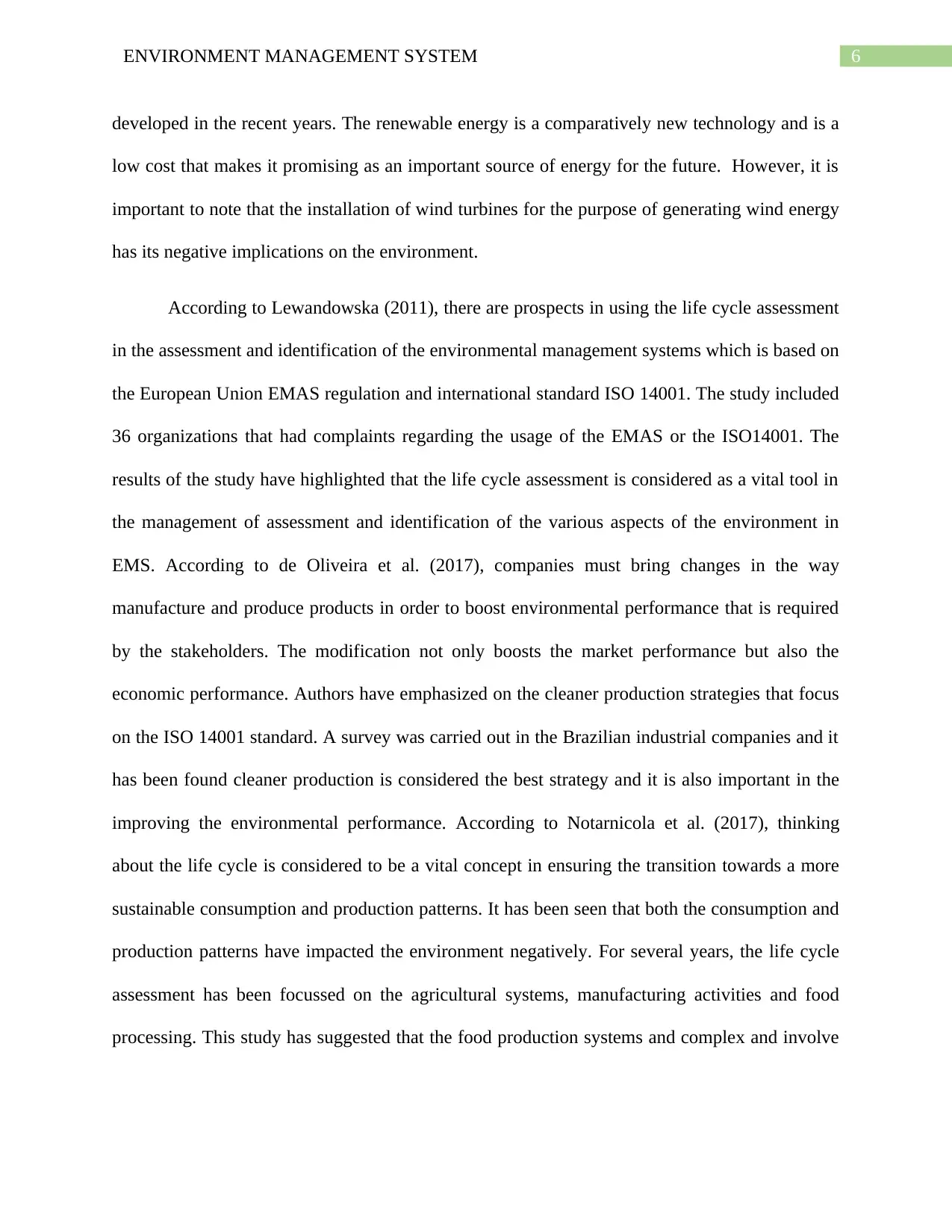
6ENVIRONMENT MANAGEMENT SYSTEM
developed in the recent years. The renewable energy is a comparatively new technology and is a
low cost that makes it promising as an important source of energy for the future. However, it is
important to note that the installation of wind turbines for the purpose of generating wind energy
has its negative implications on the environment.
According to Lewandowska (2011), there are prospects in using the life cycle assessment
in the assessment and identification of the environmental management systems which is based on
the European Union EMAS regulation and international standard ISO 14001. The study included
36 organizations that had complaints regarding the usage of the EMAS or the ISO14001. The
results of the study have highlighted that the life cycle assessment is considered as a vital tool in
the management of assessment and identification of the various aspects of the environment in
EMS. According to de Oliveira et al. (2017), companies must bring changes in the way
manufacture and produce products in order to boost environmental performance that is required
by the stakeholders. The modification not only boosts the market performance but also the
economic performance. Authors have emphasized on the cleaner production strategies that focus
on the ISO 14001 standard. A survey was carried out in the Brazilian industrial companies and it
has been found cleaner production is considered the best strategy and it is also important in the
improving the environmental performance. According to Notarnicola et al. (2017), thinking
about the life cycle is considered to be a vital concept in ensuring the transition towards a more
sustainable consumption and production patterns. It has been seen that both the consumption and
production patterns have impacted the environment negatively. For several years, the life cycle
assessment has been focussed on the agricultural systems, manufacturing activities and food
processing. This study has suggested that the food production systems and complex and involve
developed in the recent years. The renewable energy is a comparatively new technology and is a
low cost that makes it promising as an important source of energy for the future. However, it is
important to note that the installation of wind turbines for the purpose of generating wind energy
has its negative implications on the environment.
According to Lewandowska (2011), there are prospects in using the life cycle assessment
in the assessment and identification of the environmental management systems which is based on
the European Union EMAS regulation and international standard ISO 14001. The study included
36 organizations that had complaints regarding the usage of the EMAS or the ISO14001. The
results of the study have highlighted that the life cycle assessment is considered as a vital tool in
the management of assessment and identification of the various aspects of the environment in
EMS. According to de Oliveira et al. (2017), companies must bring changes in the way
manufacture and produce products in order to boost environmental performance that is required
by the stakeholders. The modification not only boosts the market performance but also the
economic performance. Authors have emphasized on the cleaner production strategies that focus
on the ISO 14001 standard. A survey was carried out in the Brazilian industrial companies and it
has been found cleaner production is considered the best strategy and it is also important in the
improving the environmental performance. According to Notarnicola et al. (2017), thinking
about the life cycle is considered to be a vital concept in ensuring the transition towards a more
sustainable consumption and production patterns. It has been seen that both the consumption and
production patterns have impacted the environment negatively. For several years, the life cycle
assessment has been focussed on the agricultural systems, manufacturing activities and food
processing. This study has suggested that the food production systems and complex and involve
Paraphrase This Document
Need a fresh take? Get an instant paraphrase of this document with our AI Paraphraser
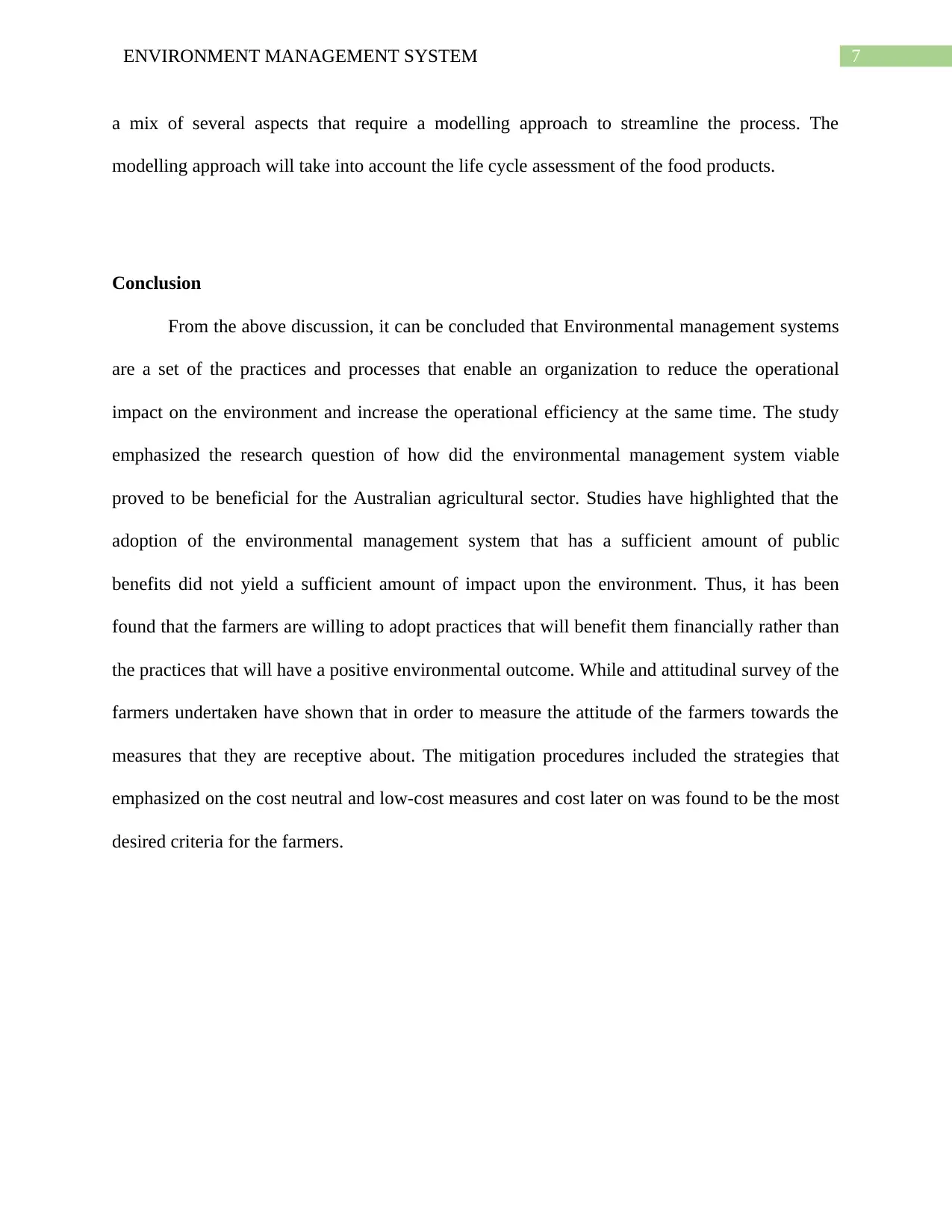
7ENVIRONMENT MANAGEMENT SYSTEM
a mix of several aspects that require a modelling approach to streamline the process. The
modelling approach will take into account the life cycle assessment of the food products.
Conclusion
From the above discussion, it can be concluded that Environmental management systems
are a set of the practices and processes that enable an organization to reduce the operational
impact on the environment and increase the operational efficiency at the same time. The study
emphasized the research question of how did the environmental management system viable
proved to be beneficial for the Australian agricultural sector. Studies have highlighted that the
adoption of the environmental management system that has a sufficient amount of public
benefits did not yield a sufficient amount of impact upon the environment. Thus, it has been
found that the farmers are willing to adopt practices that will benefit them financially rather than
the practices that will have a positive environmental outcome. While and attitudinal survey of the
farmers undertaken have shown that in order to measure the attitude of the farmers towards the
measures that they are receptive about. The mitigation procedures included the strategies that
emphasized on the cost neutral and low-cost measures and cost later on was found to be the most
desired criteria for the farmers.
a mix of several aspects that require a modelling approach to streamline the process. The
modelling approach will take into account the life cycle assessment of the food products.
Conclusion
From the above discussion, it can be concluded that Environmental management systems
are a set of the practices and processes that enable an organization to reduce the operational
impact on the environment and increase the operational efficiency at the same time. The study
emphasized the research question of how did the environmental management system viable
proved to be beneficial for the Australian agricultural sector. Studies have highlighted that the
adoption of the environmental management system that has a sufficient amount of public
benefits did not yield a sufficient amount of impact upon the environment. Thus, it has been
found that the farmers are willing to adopt practices that will benefit them financially rather than
the practices that will have a positive environmental outcome. While and attitudinal survey of the
farmers undertaken have shown that in order to measure the attitude of the farmers towards the
measures that they are receptive about. The mitigation procedures included the strategies that
emphasized on the cost neutral and low-cost measures and cost later on was found to be the most
desired criteria for the farmers.
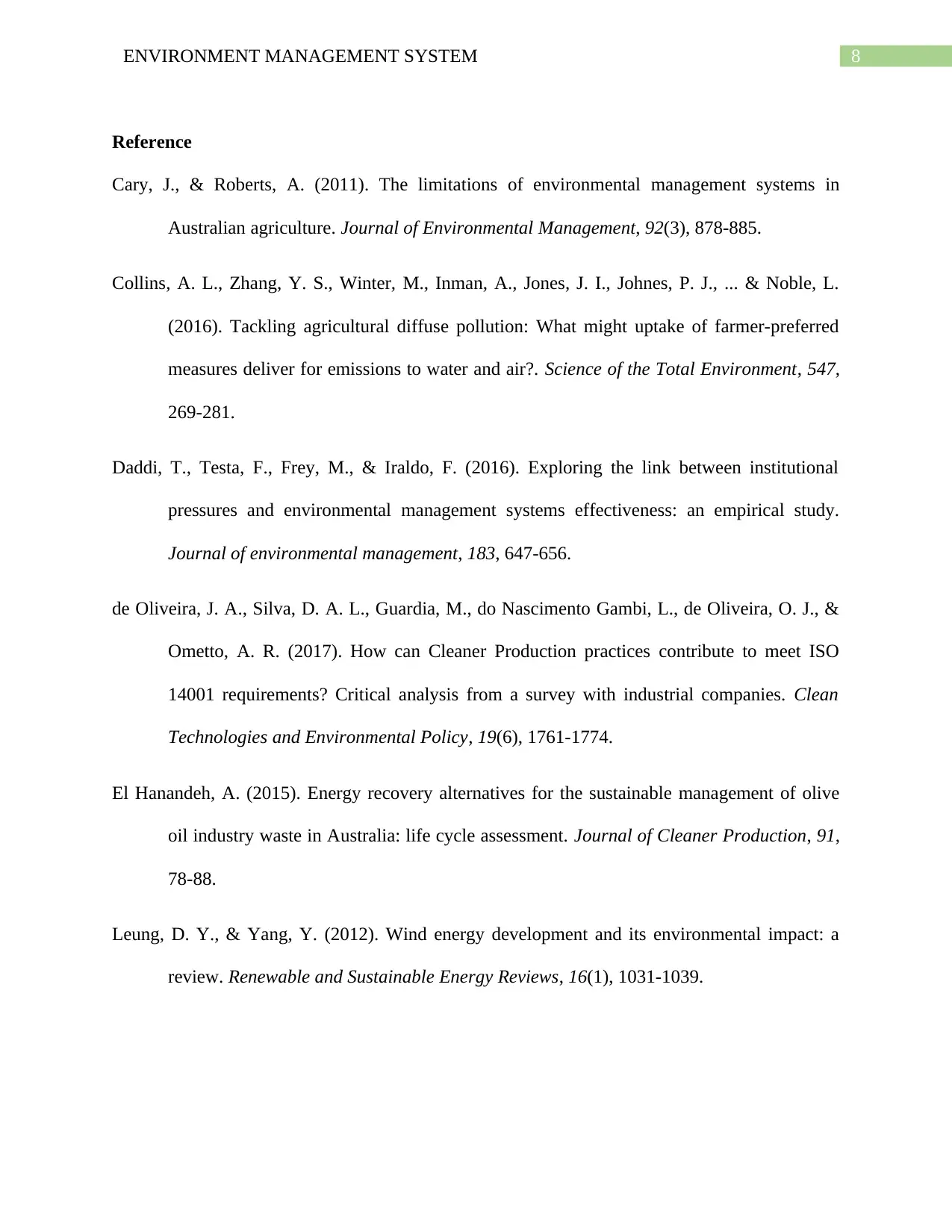
8ENVIRONMENT MANAGEMENT SYSTEM
Reference
Cary, J., & Roberts, A. (2011). The limitations of environmental management systems in
Australian agriculture. Journal of Environmental Management, 92(3), 878-885.
Collins, A. L., Zhang, Y. S., Winter, M., Inman, A., Jones, J. I., Johnes, P. J., ... & Noble, L.
(2016). Tackling agricultural diffuse pollution: What might uptake of farmer-preferred
measures deliver for emissions to water and air?. Science of the Total Environment, 547,
269-281.
Daddi, T., Testa, F., Frey, M., & Iraldo, F. (2016). Exploring the link between institutional
pressures and environmental management systems effectiveness: an empirical study.
Journal of environmental management, 183, 647-656.
de Oliveira, J. A., Silva, D. A. L., Guardia, M., do Nascimento Gambi, L., de Oliveira, O. J., &
Ometto, A. R. (2017). How can Cleaner Production practices contribute to meet ISO
14001 requirements? Critical analysis from a survey with industrial companies. Clean
Technologies and Environmental Policy, 19(6), 1761-1774.
El Hanandeh, A. (2015). Energy recovery alternatives for the sustainable management of olive
oil industry waste in Australia: life cycle assessment. Journal of Cleaner Production, 91,
78-88.
Leung, D. Y., & Yang, Y. (2012). Wind energy development and its environmental impact: a
review. Renewable and Sustainable Energy Reviews, 16(1), 1031-1039.
Reference
Cary, J., & Roberts, A. (2011). The limitations of environmental management systems in
Australian agriculture. Journal of Environmental Management, 92(3), 878-885.
Collins, A. L., Zhang, Y. S., Winter, M., Inman, A., Jones, J. I., Johnes, P. J., ... & Noble, L.
(2016). Tackling agricultural diffuse pollution: What might uptake of farmer-preferred
measures deliver for emissions to water and air?. Science of the Total Environment, 547,
269-281.
Daddi, T., Testa, F., Frey, M., & Iraldo, F. (2016). Exploring the link between institutional
pressures and environmental management systems effectiveness: an empirical study.
Journal of environmental management, 183, 647-656.
de Oliveira, J. A., Silva, D. A. L., Guardia, M., do Nascimento Gambi, L., de Oliveira, O. J., &
Ometto, A. R. (2017). How can Cleaner Production practices contribute to meet ISO
14001 requirements? Critical analysis from a survey with industrial companies. Clean
Technologies and Environmental Policy, 19(6), 1761-1774.
El Hanandeh, A. (2015). Energy recovery alternatives for the sustainable management of olive
oil industry waste in Australia: life cycle assessment. Journal of Cleaner Production, 91,
78-88.
Leung, D. Y., & Yang, Y. (2012). Wind energy development and its environmental impact: a
review. Renewable and Sustainable Energy Reviews, 16(1), 1031-1039.
⊘ This is a preview!⊘
Do you want full access?
Subscribe today to unlock all pages.

Trusted by 1+ million students worldwide
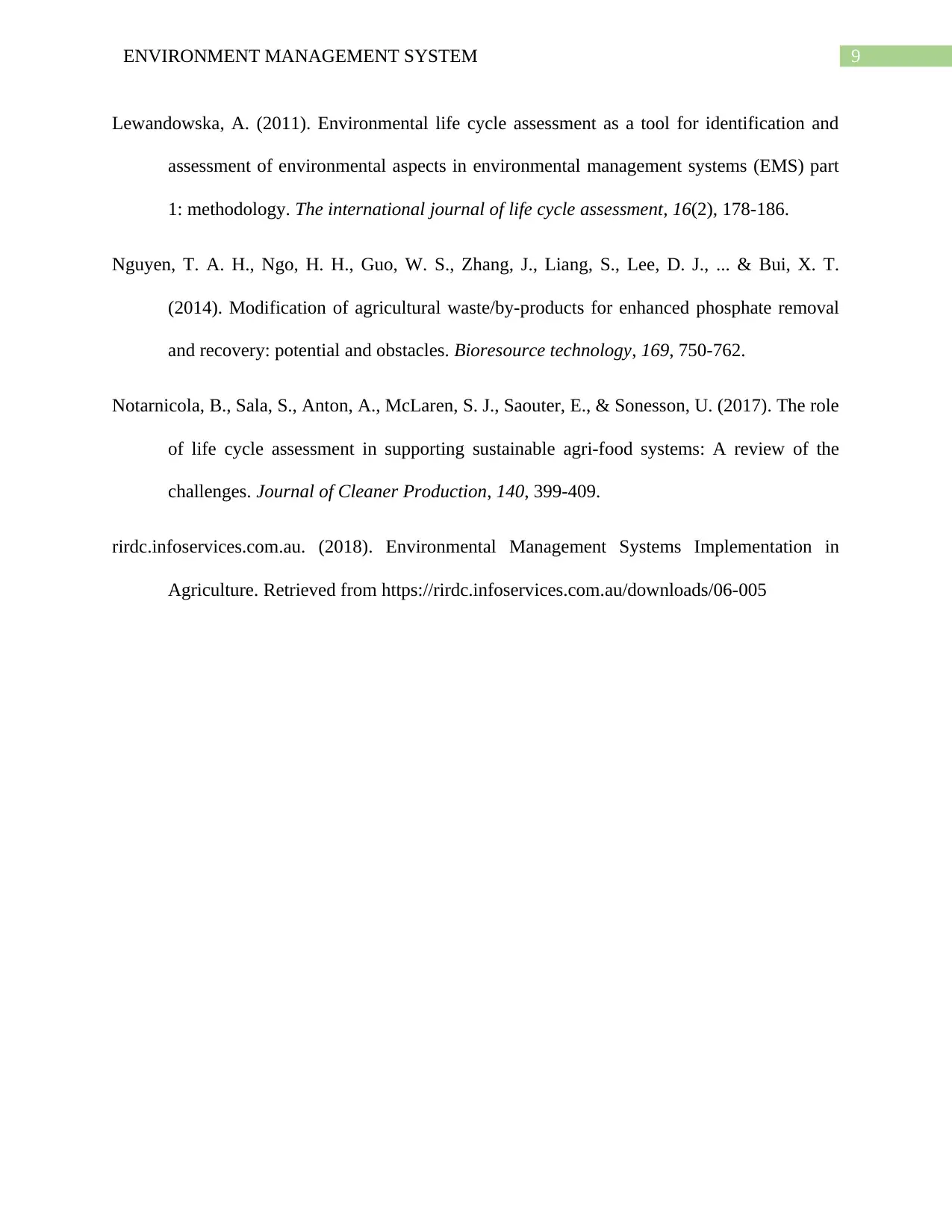
9ENVIRONMENT MANAGEMENT SYSTEM
Lewandowska, A. (2011). Environmental life cycle assessment as a tool for identification and
assessment of environmental aspects in environmental management systems (EMS) part
1: methodology. The international journal of life cycle assessment, 16(2), 178-186.
Nguyen, T. A. H., Ngo, H. H., Guo, W. S., Zhang, J., Liang, S., Lee, D. J., ... & Bui, X. T.
(2014). Modification of agricultural waste/by-products for enhanced phosphate removal
and recovery: potential and obstacles. Bioresource technology, 169, 750-762.
Notarnicola, B., Sala, S., Anton, A., McLaren, S. J., Saouter, E., & Sonesson, U. (2017). The role
of life cycle assessment in supporting sustainable agri-food systems: A review of the
challenges. Journal of Cleaner Production, 140, 399-409.
rirdc.infoservices.com.au. (2018). Environmental Management Systems Implementation in
Agriculture. Retrieved from https://rirdc.infoservices.com.au/downloads/06-005
Lewandowska, A. (2011). Environmental life cycle assessment as a tool for identification and
assessment of environmental aspects in environmental management systems (EMS) part
1: methodology. The international journal of life cycle assessment, 16(2), 178-186.
Nguyen, T. A. H., Ngo, H. H., Guo, W. S., Zhang, J., Liang, S., Lee, D. J., ... & Bui, X. T.
(2014). Modification of agricultural waste/by-products for enhanced phosphate removal
and recovery: potential and obstacles. Bioresource technology, 169, 750-762.
Notarnicola, B., Sala, S., Anton, A., McLaren, S. J., Saouter, E., & Sonesson, U. (2017). The role
of life cycle assessment in supporting sustainable agri-food systems: A review of the
challenges. Journal of Cleaner Production, 140, 399-409.
rirdc.infoservices.com.au. (2018). Environmental Management Systems Implementation in
Agriculture. Retrieved from https://rirdc.infoservices.com.au/downloads/06-005
1 out of 10
Related Documents
Your All-in-One AI-Powered Toolkit for Academic Success.
+13062052269
info@desklib.com
Available 24*7 on WhatsApp / Email
![[object Object]](/_next/static/media/star-bottom.7253800d.svg)
Unlock your academic potential
Copyright © 2020–2025 A2Z Services. All Rights Reserved. Developed and managed by ZUCOL.





